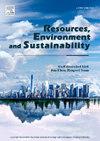Dynamic nitrogen metabolism in urban environments: Cross-sectoral and cross-media insights for sustainable management
IF 12.4
Q1 ENVIRONMENTAL SCIENCES
引用次数: 0
Abstract
The effective management of nitrogen pollution in urban environments presents unique challenges due to the cross-sectoral and cross-media characteristics of nitrogen migration and transformation. Using Macao as a case study, this research dynamically simulates urban nitrogen metabolism from 2000 to 2021 to explore its trends, drivers, and environmental implications. Through Element Flow Analysis, a cross-sectoral and cross-media nitrogen metabolism model was developed to identify critical pathways and key sectors in nitrogen dynamics. Results reveal a significant increase in nitrogen input, output, and environmental load during the study period. The food sector dominated urban nitrogen metabolism, contributing 46.35% of total nitrogen inputs, with an average annual input exceeding 3000 tons. Soil and water bodies experienced cumulative N inputs of approximately 5700 tons and 28000 tons, respectively, while atmospheric nitrogen flows decreased by 10.49%. The study identified insufficient wastewater treatment capacity and pipeline leakage as primary contributors to nitrogen emissions, alongside significant deficiencies in organic waste recovery. Driving force analysis highlights population growth and shifts as dominant factors influencing nitrogen metabolism. Ecological Network Analysis further reveals complex interactions within the nitrogen cycle, emphasizing the need for integrated urban management strategies. This study underscores the urgency of coordinated cross-sectoral and cross-media approaches to mitigate urban nitrogen pollution, providing actionable insights for sustainable urban resource management and policy development.

城市环境中的动态氮代谢:可持续管理的跨部门和跨媒体见解
由于氮的迁移和转化具有跨部门和跨媒介的特点,有效管理城市环境中的氮污染面临着独特的挑战。本研究以澳门为例,动态模拟2000 - 2021年的城市氮代谢,探讨其趋势、驱动因素和环境影响。通过元素流分析,建立了一个跨部门、跨媒介的氮代谢模型,以确定氮动力学的关键途径和关键部门。结果表明,研究期间氮素的输入、输出和环境负荷均显著增加。城市氮代谢以食品行业为主,占总氮投入的46.35%,年平均投入超过3000吨。土壤和水体的累计氮输入分别约为5700吨和28000吨,而大气氮流量减少了10.49%。该研究发现,污水处理能力不足和管道泄漏是氮排放的主要原因,同时有机废物回收方面也存在重大缺陷。驱动力分析强调人口增长和人口迁移是影响氮代谢的主要因素。生态网络分析进一步揭示了氮循环内部复杂的相互作用,强调了综合城市管理策略的必要性。本研究强调了采取协调的跨部门和跨媒体方法来缓解城市氮污染的紧迫性,为可持续的城市资源管理和政策制定提供了可操作的见解。
本文章由计算机程序翻译,如有差异,请以英文原文为准。
求助全文
约1分钟内获得全文
求助全文
来源期刊

Resources Environment and Sustainability
Environmental Science-Environmental Science (miscellaneous)
CiteScore
15.10
自引率
0.00%
发文量
41
审稿时长
33 days
 求助内容:
求助内容: 应助结果提醒方式:
应助结果提醒方式:


